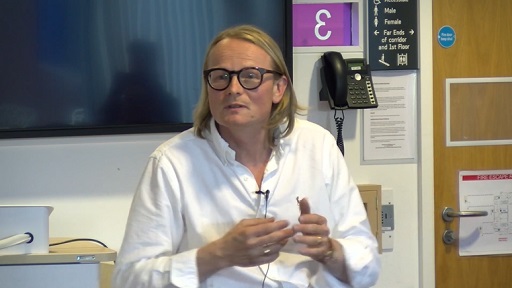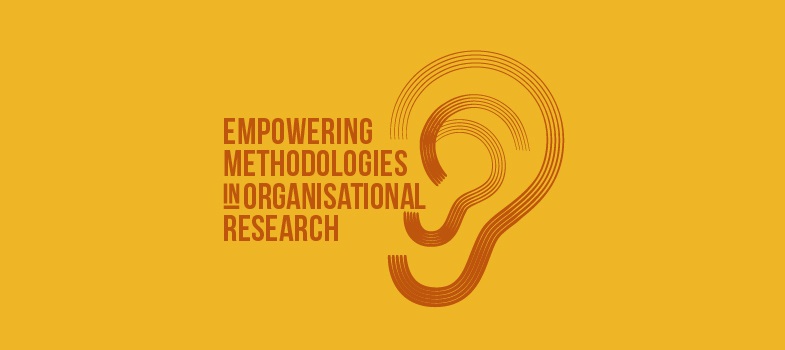Embodied research
Embodied research can also be enabled by different ways of using language, including those more conventionally associated with humanities disciplines than social sciences. Stewart’s imaginative, ficto-critical approach to writing uses language to convey (and evoke in the reader), the everyday, sensory affects that are provoked by material encounters, by using the author’s body as the ‘point of contact’ (Stewart, 2007: 5). This immersive style of writing was used by Emma in her co-authored study of craft work organisations (Bell and Vachhani, 2019) in order to try to convey the affects she experienced as a researcher studying craft work organisations. The emerging trend towards writing differently in organisation studies (see Gilmore et al., 2019) presents opportunities for empowering research by opening up possibilities for more embodied styles of research writing.
Activity: Film Focus 11, ‘Embodied research: theoretical perspectives’ – Torkild Thanem, Stockholm University, Sweden
Watch the film and make your own notes in response to the following questions:
- How might you ‘flesh out’ embodied aspects of social life in your own research?
- How could embodied research methods enhance the
verisimilitude of your research?

Transcript
With the book, it starts off from quite a simple basic starting point, that social life is embodied. The social world is embodied.
We’ve just merged from one kind of embodied social encounter, namely the coffee break, where we [were] more or less free to move about and satisfy our bodily needs of hunger and thirst and coffee and caffeine shots and so on. And we moved into quite a different organisation of bodies and in space, a more sedentary organisation of bodies and space.
And, of course, well, you’re sitting here using your bodies looking at me, maybe looking at something someone else or looking in the ceiling, while I’m here gesticulating and then making all sorts of grimaces and facial expressions and so on and so forth. These, of course, these are fundamental acts of fundamental parts of social action and social interaction.
So social life isn’t quite – we can’t quite do what Durkheim did in the nineteenth century and reduce social life and society to a matter of collective consciousness to a collection of minds. But what we need to do is – I know that many of you have perhaps done so even more than I’ve done – acknowledge the embodied nature of social life. And that, of course, means something, that has implications for the kinds of methods that we use.
Well, maybe not the kinds of methods that we use, because in this book, you’ll recognise many of those methods from ordinary qualitative research interviews, field work, and so on. But I think it triggers us to think differently about how we relate to those methods to those procedures of generating empirical material, of making sense of that empirical material, or creating qualitative knowledge.
And another point that we want to make is that, you know, since, obviously, we’re all bodies insofar as we are human beings in the social world, then why pretend as if we as scholars, as researchers are disembodied? So anyway, I’ll come back to some of these issues again.
Now, in a way, this is the worst possible time of launching a book under the title Embodied Research Methods because what we’ve been witnessing with the rise of right-wing populism, nationalism, fascism, religious extremism is really, you know, the worst corruption of embodied knowledge, the worst kind of possible exploitation of embodied knowledge. And embodied knowledge being taken to the worst kinds of extremes.
Well, maybe we shouldn’t call it knowledge. But anyway, politicians and businessmen, like this fellow, they certainly show how powerful and effective our bodily gestures and facial expressions can be in making political points and making political claims and passing off lies for facts and knowledge. It’s almost, you know, what we’re seeing here is the relativisation of knowledge, of embodied knowledge, knowledge taken to extremes where knowledge becomes a matter of speaking from the gut and shooting from the hip.
Perhaps, you know, rightly so this has caused alarm across the world. And it’s also triggered a particular epistemological response, which Emma spoke to earlier this morning, namely, a neo-positivist response. A reaction that as if in order to secure the world from this kind of politics and these kinds of knowledge claims, we need to collect hard facts. We need to cultivate our objectivity, we need to maximise our rationality. And in order to do so, we need to be as cool and distant as possible. We need, in other words, to disembody ourselves.
So for qualitative researchers, and particularly those of us keen to explore all the possibilities, challenges and limitations of embodied research methods, this poses an amazing challenge. It poses an amazing challenge. And it used to depress me immensely. It certainly made me question the very point of what I’m doing. So I’ve been haunted by this for several months, maybe several years now.
But of course, you know, this is just one side. This is just the ugly side of embodied politics. There are more joyful, progressive, radical sides to embodied politics as well. You’ll probably recognise this photograph from the Woman’s March on Washington January 2016, which brought together feminist groups, environmentalist groups, LGBT groups and a variety of political and social movements in the fight, not simply for identity politics, but a fight for the protection and preservation of our basic human rights.
So on the joyful side, the ugly face of body politics has, I think, triggered and fuelled and empowered, if you like, a more progressive, radical and joyful embodied politics. And as we can see, this is politics exercised collectively with and through people’s bodies.
So I don’t think we need to accept this hard return, this hard appeal for a return to dominant rationality of hard facts and objectivism. I’m not denying that the generation of facts plays an important role in the entire generation of scholarly knowledge. And I’m not denying that we need to be as open-minded as possible when crafting our arguments and trying to make sense of our empirical material. But what I care to pick a fight with is how this shouldn’t necessarily involve a return to a disembodied rationality.
The challenge for us as social scientists is, you know, if we accept the premise that social life and the social world is embodied that, it consists of embodied encounters between people, then I think we also should do what we can to flesh out those embodied aspects of social life. And that doesn’t necessarily mean using completely different methods of generating data or analysing and interpreting empirical material. But I think it does and it should, perhaps, affect the ways in which we work with those procedures, with those methods.
I mean, what’s an interview? Sure, you ask questions in interviews to get answers. You exchange words in interviews. We all do that. We all want answers. We want verbal answers to our research questions.
But there’s so much else going on, certainly in the face-to-face interview. There’s body language. There’s the exchange of facial expressions and gestures, points and nods, and shakings of the head, and different kinds of postures, bodily postures, and so on and so forth.
And of course, there’s a considerable populistic literature from psychology and also in the business press about how best to decipher someone’s body language and their facial expressions. That’s not quite the point that we are making in this book. Instead, I think, you know, what we find valuable, what we find useful with regards to body language, facial expressions and bodily movements and postures and so on in those kinds of face-to-face encounters is it adds richness. It adds some nuance. It adds life to those kinds of encounters, to those kinds of face-to-face encounters, which your face-to-face interview is.
I think if we’re able to try and express some of that liveliness and vivacity when we transcribe our interviews and when we draw on our interviews in books, in journal articles, think that will help us enhance the affectivity and the vivacity of what we are writing.
We recommend that you keep notes of your answers to these questions so you can return to them during the course.
Introduction
